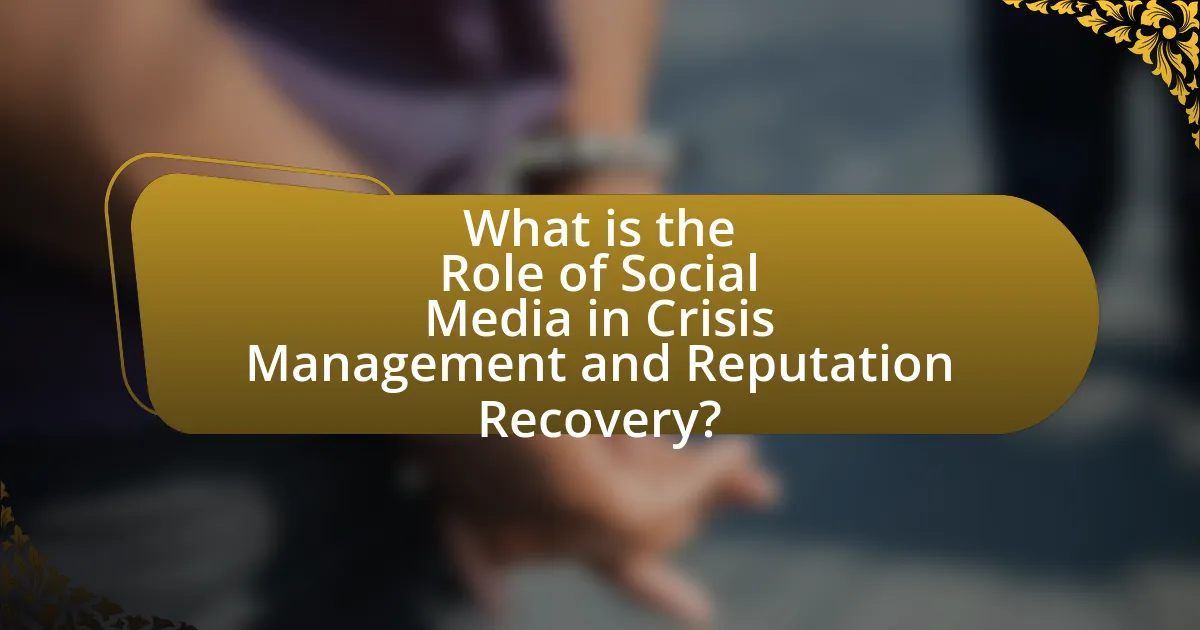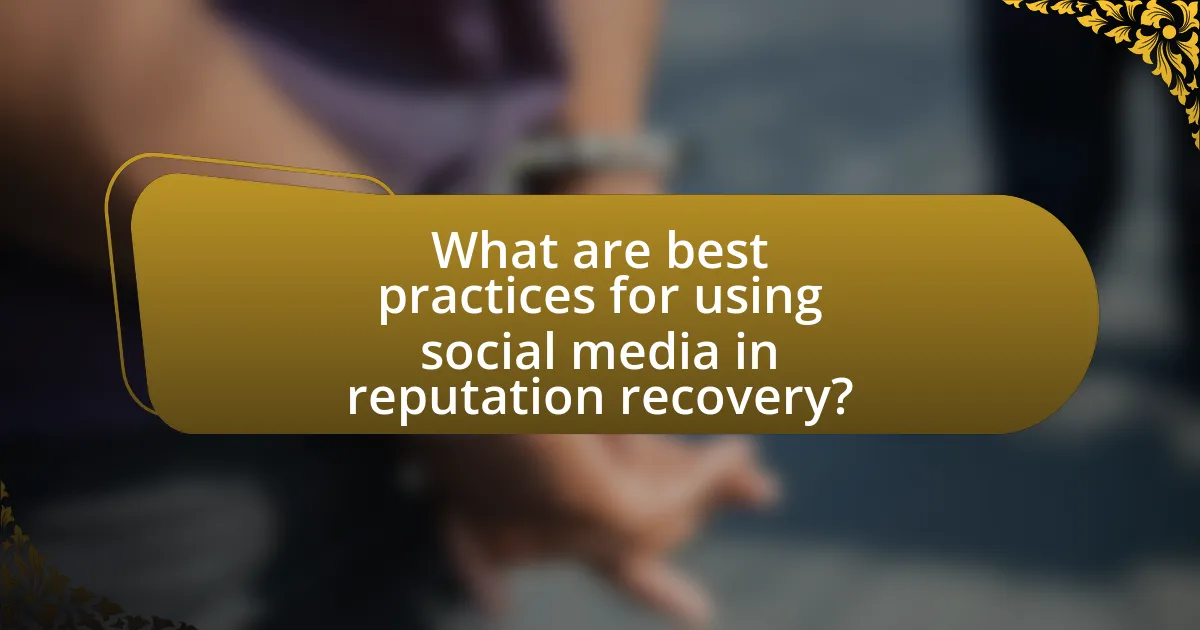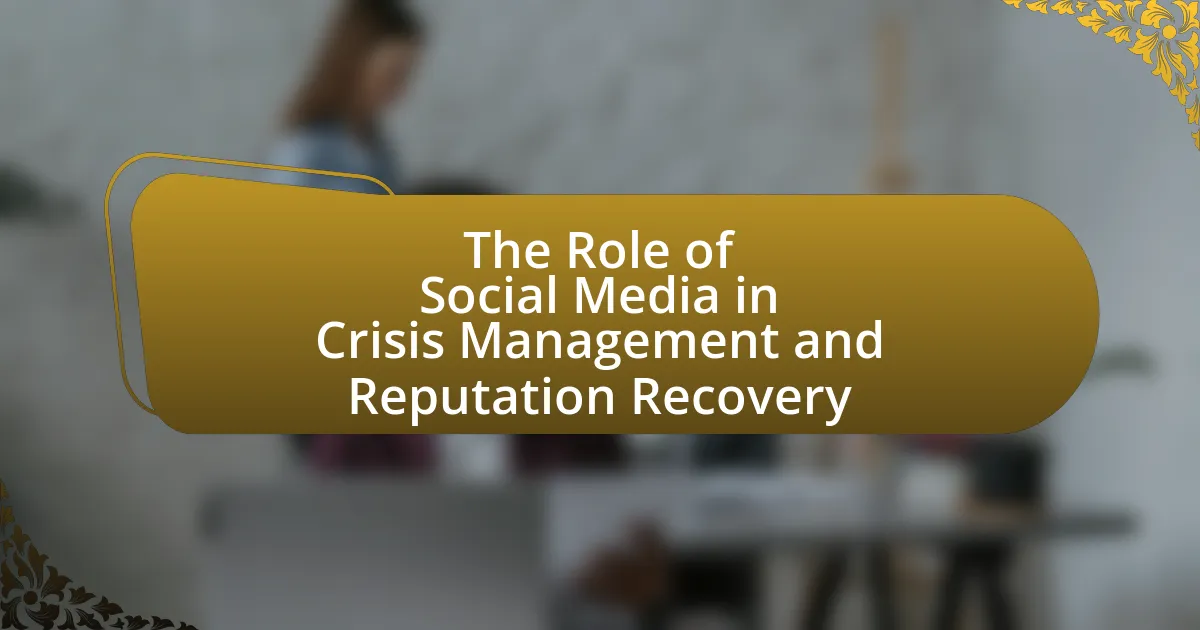The article examines the critical role of social media in crisis management and reputation recovery for organizations. It highlights how social media facilitates real-time communication, enabling organizations to disseminate accurate information, counter misinformation, and engage with stakeholders during crises. Key features such as broad reach and user-generated content are discussed, along with strategies for effective engagement and timely communication. The article also addresses the importance of reputation recovery, the challenges organizations face, and best practices for leveraging social media to rebuild trust and manage public perception effectively.

What is the Role of Social Media in Crisis Management and Reputation Recovery?
Social media plays a crucial role in crisis management and reputation recovery by facilitating real-time communication and engagement with stakeholders. During a crisis, organizations can use social media platforms to disseminate accurate information quickly, counter misinformation, and address public concerns directly, which helps to maintain transparency and trust. For instance, a study by the Pew Research Center found that 69% of adults in the U.S. use social media, making it an effective channel for reaching a large audience during critical situations. Additionally, social media allows organizations to monitor public sentiment and feedback, enabling them to adapt their strategies and messaging accordingly. This proactive engagement can significantly aid in rebuilding reputation post-crisis, as seen in cases where companies effectively utilized social media to communicate their recovery efforts and demonstrate accountability.
How does social media influence crisis management strategies?
Social media significantly influences crisis management strategies by enabling real-time communication and information dissemination. Organizations can quickly address issues, respond to public concerns, and manage their reputation during crises through platforms like Twitter and Facebook. For instance, during the 2010 BP oil spill, the company faced backlash on social media, prompting them to enhance their communication strategy to mitigate damage. Research indicates that 78% of consumers expect brands to respond to social media inquiries within an hour during a crisis, highlighting the necessity for timely engagement. Thus, social media acts as both a tool for immediate response and a platform for public sentiment monitoring, shaping how organizations formulate their crisis management approaches.
What are the key features of social media that aid in crisis management?
The key features of social media that aid in crisis management include real-time communication, broad reach, and user-generated content. Real-time communication allows organizations to disseminate information quickly, which is crucial during a crisis to prevent misinformation and keep stakeholders informed. For instance, during natural disasters, platforms like Twitter enable authorities to share updates instantly, reaching millions within seconds. The broad reach of social media ensures that messages can be distributed widely, engaging diverse audiences across geographical boundaries. Additionally, user-generated content provides authentic perspectives and can enhance transparency, as individuals share their experiences and insights during a crisis. This feature fosters community engagement and can help organizations gauge public sentiment, allowing for more effective response strategies.
How do organizations utilize social media during a crisis?
Organizations utilize social media during a crisis to communicate timely information, manage public perception, and engage with stakeholders. By providing real-time updates, organizations can quickly disseminate critical information to mitigate misinformation and reassure the public. For instance, during the COVID-19 pandemic, many health organizations used platforms like Twitter and Facebook to share guidelines and updates, which helped to inform and educate the public effectively. Furthermore, social media allows organizations to respond directly to inquiries and concerns, fostering a sense of transparency and trust. According to a study by the Pew Research Center, 53% of social media users reported that they rely on these platforms for news during emergencies, highlighting the importance of social media as a communication tool in crisis situations.
Why is reputation recovery important in crisis management?
Reputation recovery is crucial in crisis management because it directly influences stakeholder trust and organizational resilience. When a crisis occurs, negative perceptions can rapidly spread, especially through social media, leading to long-term damage to a brand’s image. For instance, a study by the Harvard Business Review found that companies with strong reputations can recover from crises more quickly and effectively, often experiencing less financial impact than those with weaker reputations. Therefore, prioritizing reputation recovery helps organizations maintain customer loyalty, attract new clients, and ensure sustained operational success in the aftermath of a crisis.
What impact does a crisis have on an organization’s reputation?
A crisis significantly damages an organization’s reputation by eroding public trust and confidence. During a crisis, negative perceptions can spread rapidly, particularly through social media platforms, leading to increased scrutiny and criticism. For instance, a study by the Institute for Public Relations found that 70% of consumers are less likely to trust a brand after a crisis, highlighting the immediate impact on reputation. Additionally, organizations may experience long-term consequences, such as decreased customer loyalty and financial losses, as seen in cases like the Volkswagen emissions scandal, where the company’s reputation suffered for years following the crisis.
How can social media facilitate reputation recovery post-crisis?
Social media can facilitate reputation recovery post-crisis by enabling real-time communication and engagement with stakeholders. This platform allows organizations to address concerns, clarify misinformation, and share positive narratives quickly. For instance, a study by the Pew Research Center found that 69% of adults in the U.S. use social media, making it a vital tool for reaching a broad audience effectively. By actively responding to feedback and showcasing transparency, organizations can rebuild trust and enhance their public image following a crisis.
What challenges do organizations face when using social media in crises?
Organizations face several challenges when using social media in crises, including misinformation, rapid information dissemination, and managing public perception. Misinformation can spread quickly on social media platforms, complicating the organization’s ability to communicate accurate information. For instance, during the 2017 United Airlines incident, false narratives circulated rapidly, impacting the company’s reputation. Rapid information dissemination can overwhelm organizations, making it difficult to respond effectively and maintain control over the narrative. Additionally, managing public perception is challenging as negative comments and reactions can escalate quickly, requiring organizations to engage in constant monitoring and response efforts. These challenges highlight the complexities organizations encounter in leveraging social media effectively during crises.
What are the risks associated with social media during a crisis?
The risks associated with social media during a crisis include the rapid spread of misinformation, potential for public panic, and damage to reputations. Misinformation can circulate quickly, leading to confusion and misinformed decisions; for example, during the COVID-19 pandemic, false information about the virus spread widely on platforms like Facebook and Twitter, complicating public health responses. Public panic can be exacerbated by sensationalized posts, which may lead to irrational behavior, as seen during natural disasters when social media amplifies fear. Additionally, organizations may face reputational harm if their responses are perceived as inadequate or if they are criticized on social media, as evidenced by numerous brands facing backlash during crises due to negative public sentiment expressed online.
How can organizations mitigate these risks effectively?
Organizations can effectively mitigate risks associated with social media in crisis management by implementing a comprehensive social media strategy that includes proactive monitoring, clear communication protocols, and employee training. Proactive monitoring allows organizations to identify potential issues before they escalate, as studies show that 70% of crises can be anticipated through social media listening tools. Clear communication protocols ensure that responses are timely and consistent, which is crucial during a crisis; research indicates that organizations that respond within an hour are perceived more favorably by the public. Additionally, training employees on social media best practices equips them to handle situations appropriately, reducing the likelihood of miscommunication or escalation.

How can organizations effectively leverage social media for crisis management?
Organizations can effectively leverage social media for crisis management by utilizing real-time communication, engaging with stakeholders, and monitoring public sentiment. Real-time communication allows organizations to disseminate accurate information quickly, which is crucial during a crisis; for instance, the Red Cross used Twitter to provide updates during natural disasters, enhancing their response efforts. Engaging with stakeholders through social media platforms fosters transparency and builds trust, as seen when companies like Starbucks addressed customer concerns directly on social media during controversies. Additionally, monitoring public sentiment through social media analytics tools helps organizations gauge the effectiveness of their messaging and adjust strategies accordingly, as demonstrated by the use of sentiment analysis during the United Airlines incident in 2017, which informed their public relations response.
What strategies should organizations implement on social media during a crisis?
Organizations should implement timely communication, transparency, and engagement strategies on social media during a crisis. Timely communication ensures that organizations provide updates as events unfold, which helps to manage public perception and reduce misinformation. Transparency involves sharing accurate information about the crisis, including what is known, what is being done, and any uncertainties, which builds trust with the audience. Engagement strategies, such as responding to inquiries and addressing concerns, foster a sense of community and support, demonstrating that the organization values its stakeholders. Research indicates that organizations that effectively communicate during crises can mitigate reputational damage and maintain stakeholder trust, as seen in the case of Johnson & Johnson during the Tylenol crisis in the 1980s, where prompt and transparent communication helped restore public confidence.
How can timely communication on social media impact crisis outcomes?
Timely communication on social media can significantly improve crisis outcomes by facilitating rapid information dissemination and audience engagement. When organizations respond quickly to crises on social media, they can control the narrative, reduce misinformation, and maintain public trust. For instance, during the 2017 United Airlines incident, the company’s prompt acknowledgment of the situation on social media helped mitigate backlash and allowed for a more effective management of public perception. Research indicates that 78% of consumers expect brands to respond to social media inquiries within an hour, highlighting the importance of timely communication in maintaining customer relationships during crises.
What role does audience engagement play in crisis management on social media?
Audience engagement is crucial in crisis management on social media as it facilitates real-time communication and fosters trust between organizations and their stakeholders. Engaging with the audience allows organizations to address concerns, clarify misinformation, and provide timely updates, which can mitigate the impact of a crisis. For instance, during the 2017 United Airlines incident, the company’s prompt engagement with customers on social media helped to manage the backlash and restore its reputation. This demonstrates that effective audience engagement not only aids in crisis resolution but also plays a significant role in reputation recovery by showing accountability and responsiveness.
How can organizations measure the effectiveness of their social media efforts in crisis management?
Organizations can measure the effectiveness of their social media efforts in crisis management through key performance indicators (KPIs) such as engagement rates, sentiment analysis, and response time. Engagement rates, which include likes, shares, and comments, indicate how well the audience is interacting with the content during a crisis. Sentiment analysis helps organizations gauge public perception by analyzing the tone of comments and mentions, providing insights into whether the sentiment is positive, negative, or neutral. Additionally, tracking response time to inquiries and comments during a crisis can reveal how quickly an organization addresses concerns, which is crucial for maintaining trust. Research by the Pew Research Center shows that timely responses on social media can significantly improve public perception, highlighting the importance of these metrics in evaluating effectiveness.
What metrics are essential for evaluating social media performance during a crisis?
The essential metrics for evaluating social media performance during a crisis include engagement rate, sentiment analysis, reach, share of voice, and response time. Engagement rate measures how users interact with content, indicating the effectiveness of messaging during a crisis. Sentiment analysis assesses public perception by analyzing the tone of comments and posts, providing insight into audience feelings. Reach quantifies the number of unique users who see the content, essential for understanding the message’s spread. Share of voice compares the brand’s mentions to competitors, revealing its visibility in the conversation. Response time tracks how quickly the organization addresses inquiries or concerns, crucial for maintaining trust. These metrics collectively provide a comprehensive view of social media effectiveness in crisis management.
How can feedback from social media inform future crisis management strategies?
Feedback from social media can inform future crisis management strategies by providing real-time insights into public sentiment and concerns during a crisis. Analyzing social media interactions allows organizations to identify key issues, gauge the effectiveness of their responses, and adjust their strategies accordingly. For instance, a study by the Pew Research Center found that 69% of adults in the U.S. use social media, making it a vital platform for gathering public opinion. By monitoring trends and reactions on these platforms, organizations can tailor their communication and actions to address specific public needs, ultimately enhancing their crisis response effectiveness.

What are best practices for using social media in reputation recovery?
Best practices for using social media in reputation recovery include promptly addressing negative feedback, engaging transparently with stakeholders, and consistently sharing positive content. Promptly addressing negative feedback allows organizations to demonstrate responsiveness and accountability, which can mitigate damage. Engaging transparently with stakeholders fosters trust and shows a commitment to improvement, as seen in cases where companies publicly acknowledge mistakes and outline corrective actions. Consistently sharing positive content helps to rebuild the brand image by highlighting achievements and customer satisfaction, which can counterbalance negative perceptions. These practices are supported by research indicating that timely and transparent communication can significantly enhance public perception during a crisis.
How can organizations rebuild trust through social media after a crisis?
Organizations can rebuild trust through social media after a crisis by actively engaging with their audience, providing transparent communication, and demonstrating accountability. Engaging with the audience involves responding promptly to inquiries and concerns, which fosters a sense of community and shows that the organization values its stakeholders. Transparent communication includes sharing accurate information about the crisis and the steps being taken to address it, which helps to eliminate misinformation and build credibility. Demonstrating accountability means acknowledging mistakes and outlining corrective actions, which can enhance the organization’s reputation and restore trust. Research indicates that organizations that effectively communicate during a crisis can recover their reputation more quickly, as seen in studies by Coombs (2007) on crisis communication strategies.
What types of content are most effective for reputation recovery on social media?
The most effective types of content for reputation recovery on social media include transparent communication, positive testimonials, and engaging visual content. Transparent communication, such as addressing the issue directly and providing updates, helps rebuild trust with the audience. Positive testimonials from satisfied customers can counteract negative perceptions and showcase the brand’s strengths. Engaging visual content, like infographics and videos, can effectively convey messages and foster emotional connections, making the recovery process more relatable. Research indicates that brands that actively engage with their audience during a crisis can see a 30% improvement in public perception within a few weeks.
How can transparency and authenticity on social media aid in recovery efforts?
Transparency and authenticity on social media can significantly enhance recovery efforts by fostering trust and engagement among stakeholders. When organizations share honest updates and acknowledge challenges during recovery, they create a sense of reliability that encourages community support and participation. For instance, during the COVID-19 pandemic, health organizations that provided clear, truthful information saw higher compliance with health guidelines, as evidenced by a study published in the Journal of Health Communication, which found that transparent communication led to increased public trust and adherence to safety measures. This trust is crucial in recovery scenarios, as it mobilizes resources and strengthens community resilience.
What common mistakes should organizations avoid when using social media for reputation recovery?
Organizations should avoid responding impulsively to negative comments on social media during reputation recovery. Impulsive responses can escalate the situation, leading to further backlash and damaging the organization’s credibility. For instance, a study by the Pew Research Center found that 70% of social media users expect brands to respond to complaints within an hour, indicating the importance of timely yet thoughtful communication. Additionally, organizations should refrain from ignoring negative feedback, as this can be perceived as dismissive and may alienate stakeholders. Engaging constructively with critics can demonstrate accountability and a willingness to improve. Furthermore, organizations must avoid inconsistent messaging across platforms, as this can confuse audiences and undermine trust. Consistency in communication reinforces the organization’s commitment to transparency and reliability. Lastly, organizations should not rely solely on automated responses, as these can come off as insincere and fail to address specific concerns raised by individuals. Personalizing responses can enhance engagement and foster a more positive relationship with the audience.
How can miscommunication on social media exacerbate reputation issues?
Miscommunication on social media can significantly exacerbate reputation issues by spreading false information rapidly and amplifying negative perceptions. When users misinterpret or misrepresent a brand’s message, it can lead to public backlash, as seen in cases where companies faced boycotts due to misunderstood statements. For instance, a study by the Pew Research Center found that 64% of Americans believe social media has a mostly negative effect on the way things are going in the country today, highlighting the potential for miscommunication to fuel public outrage. This rapid dissemination of misinformation can damage trust and credibility, making it challenging for organizations to recover their reputation.
What strategies can prevent backlash on social media during recovery efforts?
To prevent backlash on social media during recovery efforts, organizations should prioritize transparent communication and proactive engagement with their audience. Transparency involves openly sharing information about the recovery process, acknowledging mistakes, and providing updates on progress, which builds trust and credibility. Proactive engagement includes actively responding to concerns, addressing misinformation, and encouraging dialogue with stakeholders. Research indicates that organizations that maintain open lines of communication during crises experience less negative sentiment and backlash, as seen in the case of Johnson & Johnson during the Tylenol crisis, where their immediate and transparent response helped restore public trust.
What practical tips can organizations follow for effective social media crisis management and reputation recovery?
Organizations can effectively manage social media crises and recover their reputation by implementing a proactive communication strategy. This includes monitoring social media channels continuously to identify potential issues early, allowing for timely responses. Establishing a crisis management team ensures that there is a dedicated group ready to address any emerging situations.
Additionally, organizations should develop clear messaging that addresses the crisis directly, providing transparency and accountability. Engaging with stakeholders through direct communication can help mitigate negative sentiments. According to a study by the Institute for Public Relations, organizations that respond quickly and transparently during a crisis can recover their reputation more effectively, with 70% of consumers indicating they are more likely to trust brands that communicate openly during difficult times.
Finally, post-crisis evaluation is essential; organizations should analyze the response and adjust their strategies based on feedback and outcomes to improve future crisis management efforts.

Leave a Reply